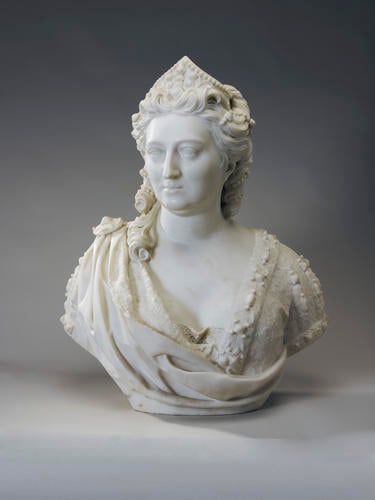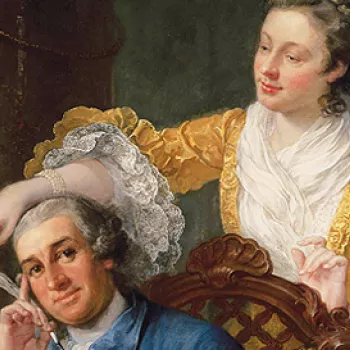Caroline, Consort of George II (1683-1737) c. 1739
Marble | 71.5 x 56.5 x 36.5 cm (whole object) | RCIN 31317

John Michael Rysbrack (1693-1770)
Caroline, Consort of George II (1683-1737) c. 1739
Royal Collection Trust/ © His Majesty King Charles III 2022



-
Queen Caroline was born on 1/11 March 1683, under the name of Wilhelmina Charlotte Caroline of Brandenburg-Ansbach. Her native principality may have been one of the smallest of the Empire, but her family, the House of Hohenzollern, was one of Germany’s most ancient and ambitious. Caroline’s early life was obscured by the premature death of her parents, John Frederick, Margrave of Brandenburg-Ansbach (1654-1686) and Eleonore of Sachsen-Eisenach (1662-1696), as well as her step-father, George IV, Elector of Saxony (1668-1694). From the age of thirteen, the orphan princess was raised in Berlin, at the court of Sophie Charlotte of Brandenburg, sister of George I. Caroline benefited greatly from the cultivated and intellectual circle of Sophie Charlotte and her mother, the Electress Sophia.
The combination of wit and beauty (and the negligible political weight of Ansbach), made Caroline one of the most sought after princesses on the European marriage market. Owing to her deep Protestant faith, she even declined the proposal of the most eligible yet Catholic candidate, future Emperor Charles VI. This remarkable rejection would later be used in Britain to publicise the Queen’s unfailing Protestantism.
Caroline first met the then Electoral Prince George Augustus of Hanover in June 1705, when he visited Ansbach incognito. George almost immediately sought his father’s approval for the match, which he received soon afterwards. George and Caroline’s relationship appears to have been one of affection and interdependency. Although her influence over the King triggered satire and mockery, he continuously relied on her advice and judgement. The Queen endured the presence of her husband’s mistresses with serene tolerance. On her death bed she thoughtfully advised him to remarry. The King’s promise that he would limit himself to mistresses was met by the Queen’s famous reply: ‘Ah mon Dieu! Cela n’empêche pas!’
A woman of unusual erudition, Queen Caroline was qualified by some of her contemporaries as ‘one of the most learned princesses in Europe.’ Keen to emphasise her affiliation to the British Monarchy in her patronage, the Queen even changed her name from Wilhelmina (as she was known in Germany) to Caroline in order to simplify the pronunciation for her English-speaking subjects.
George Vertue provides valuable information on the origin of this bust and another of George II (RCIN 31322). In 1738 he noted that ‘the KING … sat to [Rysbrack] at Kensington twice. to have his picture modelled in Clay. the likeness much approvd on – and with a good Air. – also a Moddel of the Queen vastly like. Tho’ not done from the life’. The resulting terracotta models, which are signed and dated 1738, can now be seen at Kensington Palace (RCIN 1411-1412). In 1739 Vertue recorded that ‘two Marble Bustos the one of his present Majesty from a Model done from the life by MrRysbrack – and another busto of the lat Majesty Q. Caroline both were erected in the New Library at St. James, Green Park’. The busts probably stood in niches over the fireplaces at either end of the double-cube interior, while Rysbrack’s terracotta kings and queens rested on high brackets along the side walls.
The two portraits, though properly a pair, are yet distinguished both by the fact that one was made posthumously and the other ‘from the life’, and by the costumes. The King wears the laurels of victory and is dressed in armour, albeit markedly old-fashioned in style. The Queen by contrast wears robes of state, with strings of pearls threaded through her hair and a high, jewelled diadem notable for its resemblance to those habitually portrayed on the goddess Juno. The likeness depends in almost every detail on her portrait in profile by the painter Joseph Highmore (RCIN 406035) which must have been placed at the sculptor’s disposal.
A further terracotta version of Queen Caroline’s bust (Amsterdam, Rijksmuseum) belonged to her daughter Anne, Princess Royal, and was recorded at the Stadholder’s court in Leeuwarden in 1764.
Text adapted from The First Georgians: Art and Monarchy 1714 - 1760, London, 2014Provenance
Commissioned by Queen Caroline
-
Creator(s)
(nationality)Acquirer(s)
-
Medium and techniques
Marble
Measurements
71.5 x 56.5 x 36.5 cm (whole object)
Category
Object type(s)








